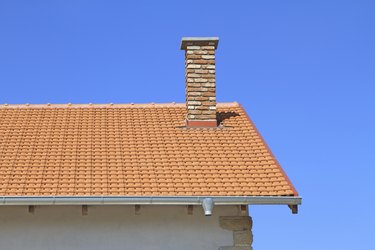Things You'll Need
Power washer
Trisodium phosphate
Bucket
Work gloves
Scrub brush
Exterior primer
1¼-inch nap roller with extended handle
Elastomeric masonry paint
Paint brush

Homeownership can be a bewitching blend of broadening your basic talents and knowing your limitations. Such may be the case if you're mulling whether to paint your concrete roof tiles. Concrete roof tiles are designed to last about 40 years, but the color can fade long before that because of sun exposure and weather damage. A fresh coat of paint on concrete roofing can invigorate the look of the entire home. If you're not afraid of heights, you can save a small fortune by tackling this job yourself.
Step 1
Remove dirt from the concrete tiles with a power washer. Tackle stubborn stains such as grease, mildew and soot by mixing a quarter-cup of trisodium phosphate per 1 gallon of water. Wear work gloves as you scrub this solution into the stains with a brush.
Video of the Day
Step 2
Prime the concrete tiles with a quality exterior primer to help the paint bond to the surface. Your paint job will not last long if you skip this step. Working from the highest portion of the roof on down, apply the primer with an extended roller. Let it dry thoroughly, following the directions on the can. For example, the primer might be dry to the touch in one hour, but the manufacturer might recommend that you wait at least 24 hours before painting.
Step 3
Paint the roof tiles on a day that the temperatures will range between 50 and 90 degrees Fahrenheit and that no rain or heavy dew is forecast for 24 hours. Apply the first coat of the elastomeric masonry paint with the extended roller. Let this first coat dry thoroughly.
Step 4
Inspect the first coat. With a paintbrush, touch up any spots on the roof that you might have missed with the roller. Then apply a second coat with roller and then paintbrush. After it dries, if you wish, apply a third coat for a most durable finish.
Tip
You might be tempted to load the masonry paint in a sprayer to expedite this job, but heed two realities: Masonry paint is thicker than regular exterior paint and can clog sprayers, and you might find yourself fighting back-spray with just a mild breeze.
Do not use regular exterior paint on concrete tiles. Whereas elastomeric masonry paint bonds and expands with concrete, regular exterior paint can simply flake and peel, especially on a roof.
Video of the Day